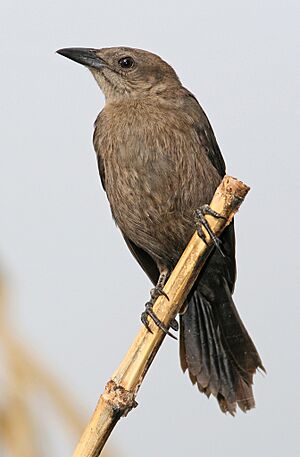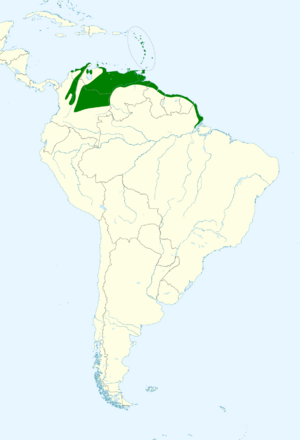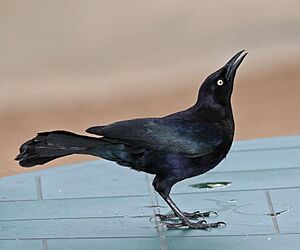Carib grackle facts for kids
Quick facts for kids Carib grackle |
|
|---|---|
 |
|
| Immature Carib grackle | |
| Conservation status | |
| Scientific classification | |
| Genus: |
Quiscalus
|
| Species: |
lugubris
|
 |
|
The Carib grackle (Quiscalus lugubris) is a type of New World blackbird. These birds live in tropical areas. You can find them in the Lesser Antilles islands and the northern parts of South America. They live east of the Andes, from Colombia all the way to Venezuela and northeastern Brazil.
There are eight different kinds, or subspecies, of the Carib grackle. The most common one is called Q. l. lugubris. This type lives in Trinidad and on the South American mainland. It was brought to Tobago in 1905 and is now very common there.
Contents
What Does the Carib Grackle Look Like?
The adult male Carib grackle is about 27 centimeters (10.6 inches) long. It has a long, wedge-shaped tail. However, its tail is not as long as some other grackle species. Its feathers are completely black and have a shiny, violet color. This shiny effect is called iridescence, which means the colors seem to change when the light hits them. The male has bright yellow eyes and a strong, dark beak.
The adult female is smaller, about 23 centimeters (9 inches) long. She has a shorter tail and brown feathers. Her upper parts are a darker brown. Young males have shorter tails than adult males and some brown feathers. Young females look very much like the adult females.
The seven types of Carib grackles that live on different islands look a bit different. They can vary in size and the shade of their feathers. This is especially true for the brown colors of the females. Their calls can also sound different from island to island.
How Do Carib Grackles Raise Their Young?
Carib grackles like to breed in open areas. This includes farms and places where people live. They are social breeders, meaning many pairs build their nests close together. Often, several deep, cup-shaped nests are built in just one tree. These nests are carefully lined inside.
A female Carib grackle usually lays two to four whitish eggs. The eggs hatch after about 12 days. The young birds then stay in the nest for another 14 days before they are ready to fly. Sometimes, another bird called the shiny cowbird tries to lay its eggs in a Carib grackle's nest. But Carib grackles are quite good at noticing and getting rid of these extra eggs.
Carib Grackle Behaviour
The Carib grackle is a very social bird. They often gather in groups. They look for food on the ground. Their diet includes insects, other small creatures without backbones (like worms), tiny fish, small frogs, lizards, and even leftover food scraps. They have also been seen catching small bats while flying!
These birds can become very comfortable around people. They might even enter restaurants to find food. At night, they gather together in large groups to sleep. If they feel threatened, Carib grackles will team up to attack possible predators. This can include dogs, mongooses, or even humans.
What Does the Carib Grackle Sound Like?
The song of the Carib grackle is a mix of sounds. It has some harsh notes and some more musical, ringing sounds. You might hear a bell-like tickita-tickita-tickita-ting or a fast chi-chi-chi-chi. The sounds they make can be different depending on which island they live on. When a Carib grackle calls, it often fluffs up its feathers.



